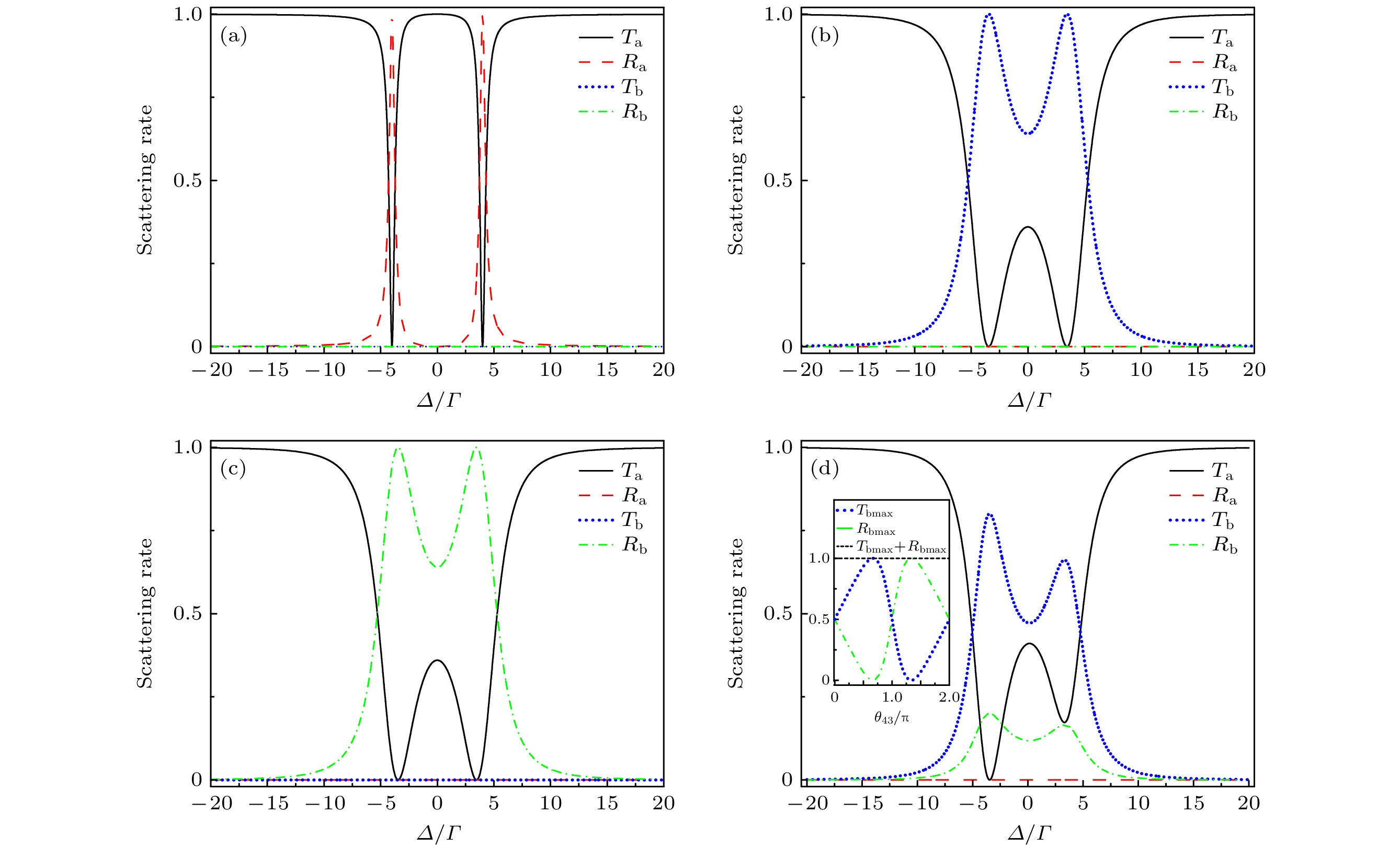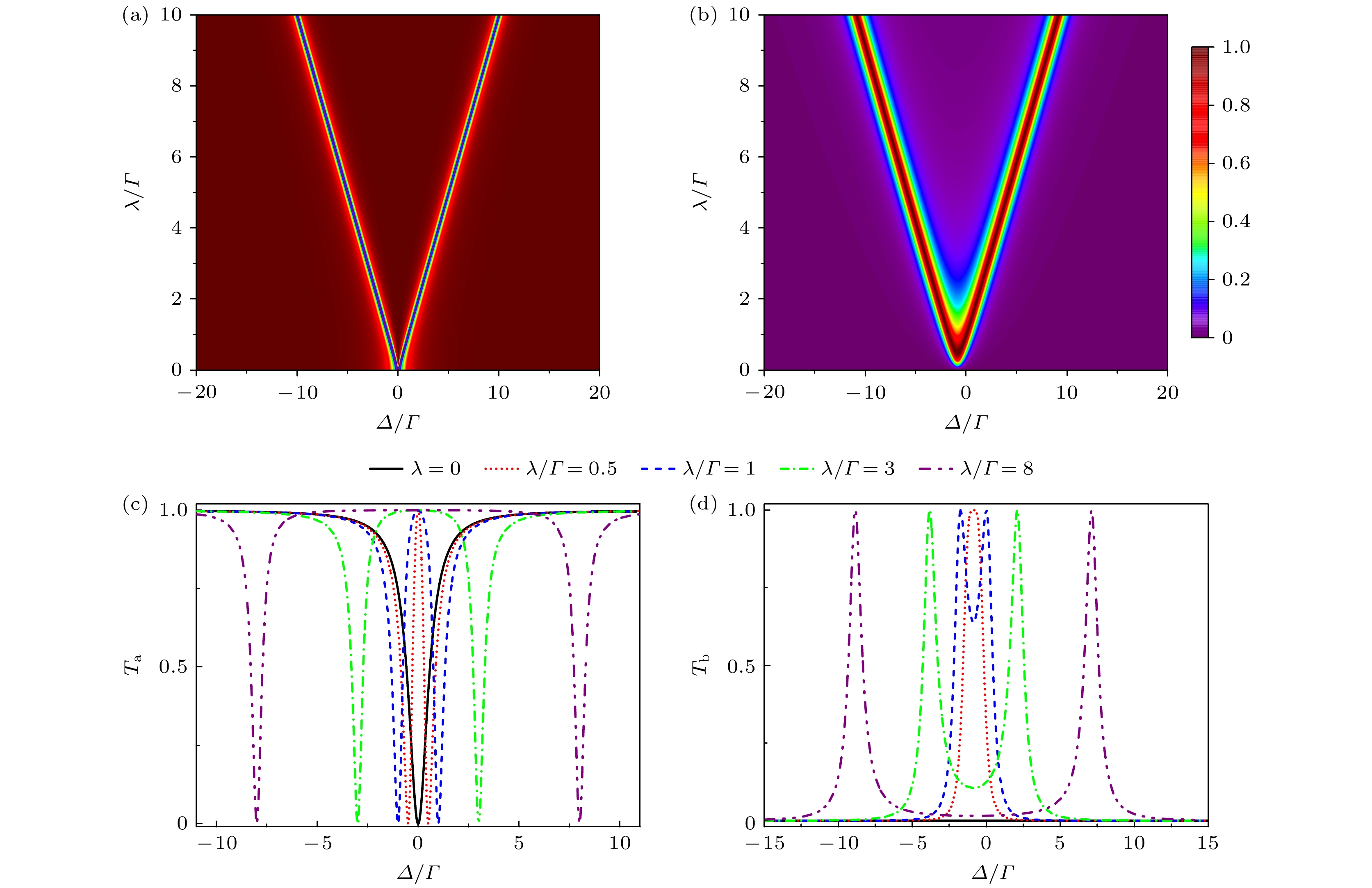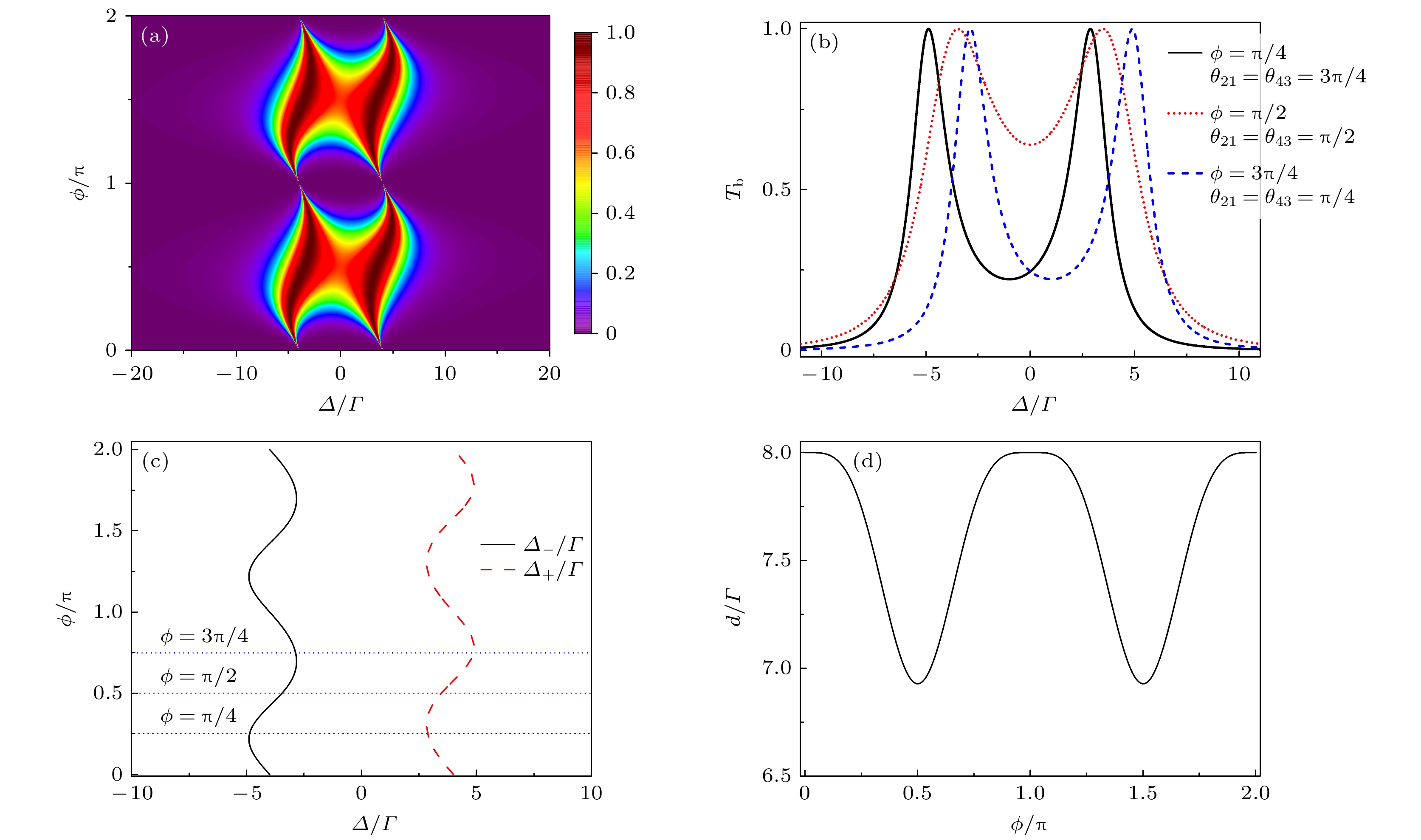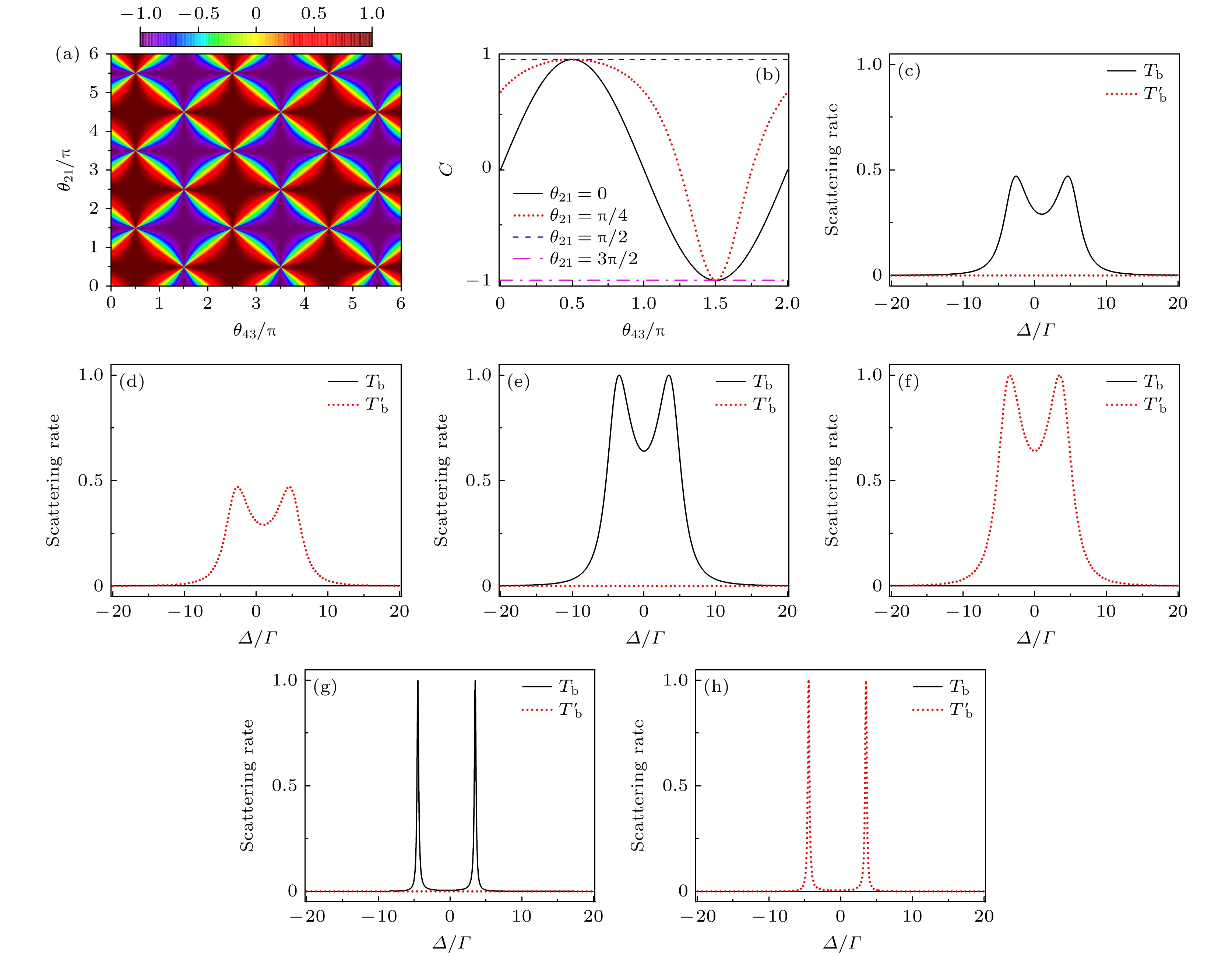-
This work is to investigate the single-photon scattering in a waveguide quantum electrodynamics system consisting of two dipole-coupled giant atoms, each interacting with a separate one-dimensional infinite waveguide at two distinct coupling points. Our primary objective is to establish a theoretical framework for manipulating photon propagation paths via quantum interference induced by multiple coupling points and local phase engineering. Unlike traditional chiral coupling schemes, an innovative method, in which the coupling phases are designed locally at each atom-waveguide interface, is used to achieve effective chiral coupling, thereby introducing novel quantum interference mechanisms. Using a real-space approach, we derive analytical expressions for four-port scattering amplitudes. We establish the conditions for achieving perfect directional routing to any output port and demonstrate the coherent control mechanisms implemented by geometric and local coupled phases. Continuous frequency tunability is primarily achieved through dipole-dipole interaction, and finely tuned through the accumulated phase and local coupling phases. Local phase differences precisely regulate port-specific probability distributions within the waveguides while preserving total routing efficiency. Furthermore, we elucidate the mechanisms of nonreciprocal transport and chiral scattering. The analysis reveals different governing principles: perfect nonreciprocity arises from the interplay of the accumulated phase, local coupling phases, photon-atom detuning, and dipole-dipole interaction. In contrast, perfect chiral scattering depends entirely on the accumulated phase and local coupling phases, and is independent of detuning. Notably, under the phase-matching conditions, the system achieves both perfect chiral and directional routing, and realizes frequency-selective path-asymmetric photon control. These findings provide a comprehensive framework for manipulating quantum interference in multi-atom waveguide systems, highlighting applications in quantum information processing, including tunable single-photon routers, isolators, and chiral quantum nodes. By implementing superconducting circuits, the local phase can be dynamically adjusted, thus proving the feasibility of the experiment.
-
Keywords:
- giant atom /
- directional routing /
- nonreciprocity /
- chiral scattering
[1] Kockum A F, Delsing P, Johansson G 2014 Phys. Rev. A 90 013837
 Google Scholar
Google Scholar
[2] Qiu Q Y, Wu Y, Lü X Y 2023 Sci. China-Phys. Mech. Astron. 66 224212
 Google Scholar
Google Scholar
[3] Wen P Y, Lin K T, Kockum A F, Suri B, Ian H, Chen J C, Mao S Y, Chiu C C, Delsing P, Nori F, Lin G D, Hoi I C 2019 Phys. Rev. Lett. 123 233602
 Google Scholar
Google Scholar
[4] Kockum A F, Johansson G, Nori F 2018 Phys. Rev. Lett. 120 140404
 Google Scholar
Google Scholar
[5] Kannan B, Ruckriegel M J, Campbell D L, Kockum A F, Braumüller J, Kim D K, Kjaergaard M, Krantz P, Melville A, Niedzielski B M, Vepsäläinen A, Winik R, Yoder J L, Nori F, Orlando T P, Gustavsson S, Oliver W D 2020 Nature 583 775
 Google Scholar
Google Scholar
[6] Carollo A, Cilluffo D, Ciccarello F 2020 Phys. Rev. Res. 2 043184
 Google Scholar
Google Scholar
[7] Du L, Guo L, Li Y 2023 Phys. Rev. A 107 023705
 Google Scholar
Google Scholar
[8] Andersson G, Suri B, Guo L, Aref T, Delsing P 2019 Nat. Phys. 15 1123
 Google Scholar
Google Scholar
[9] Guo L, Kockum A F, Marquardt F, Johansson G 2020 Phys. Rev. Res. 2 043014
 Google Scholar
Google Scholar
[10] Guo S, Wang Y, Purdy T, Taylor J 2020 Phys. Rev. A 102 033706
 Google Scholar
Google Scholar
[11] Zhao W, Wang Z H 2020 Phys. Rev. A 101 053855
 Google Scholar
Google Scholar
[12] Wang X, Liu T, Kockum A F, Li H R, Nori F 2021 Phys. Rev. Lett. 126 043602
 Google Scholar
Google Scholar
[13] Lodahl P, Mahmoodian S, Stobbe S, Rauschenbeutel A, Schneeweiss P, Volz J, Zoller P 2017 Nature 541 473
 Google Scholar
Google Scholar
[14] Soro A, Kockum A F 2022 Phys. Rev. A 105 023712
 Google Scholar
Google Scholar
[15] Wang X, Li H R 2022 Quantum Sci. Technol. 7 035007
 Google Scholar
Google Scholar
[16] Chen Y T, Du L, Guo L, Wang Z, Zhang Y, Li Y, Wu J H 2022 Commun. Phys. 5 215
 Google Scholar
Google Scholar
[17] Zhou J, Yin X L, Liao J Q 2023 Phys. Rev. A 107 063703
 Google Scholar
Google Scholar
[18] Joshi C, Yang F, Mirhosseini M 2023 Phys. Rev. X 13 021039
 Google Scholar
Google Scholar
[19] Li J, Lu J, Gong Z R, Zhou L 2024 New J. Phys. 26 033025
 Google Scholar
Google Scholar
[20] Chen Y T, Du L, Wang Z H, Artoni M, La Rocca G C, Wu J H 2024 Phys. Rev. A 109 063710
 Google Scholar
Google Scholar
[21] Zheng J C, Dong X L, Chen J Q, Hei X L, Pan X F, Yao X Y, Ren Y M, Qiao Y F, Li P B 2024 Phys. Rev. A 109 063709
 Google Scholar
Google Scholar
[22] Du L, Chen Y T, Li Y 2021 Phys. Rev. Res. 3 043226
 Google Scholar
Google Scholar
[23] Guo L, Grimsmo A L, Kockum A F, Pletyukhov M, Johansson G 2017 Phys. Rev. A 95 053821
 Google Scholar
Google Scholar
[24] Zhu Y T, Xue S, Wu R B, Li W L, Peng Z H, Jiang M 2022 Phys. Rev. A 106 043710
 Google Scholar
Google Scholar
[25] Yu H, Wang Z, Wu J H 2021 Phys. Rev. A 104 013720
 Google Scholar
Google Scholar
[26] Yin X L, Luo W B, Liao J Q 2022 Phys. Rev. A 106 063703
 Google Scholar
Google Scholar
[27] Santos A C, Bachelard R 2023 Phys. Rev. Lett. 130 053601
 Google Scholar
Google Scholar
[28] Yin X L, Liao J Q 2023 Phys. Rev. A 108 023728
 Google Scholar
Google Scholar
[29] Cai G, Ma X S, Huang X, Cheng M T 2024 Opt. Express 32 969
 Google Scholar
Google Scholar
[30] Ma X S, Quan J H, Lu Y N, Cheng M T 2024 Quantum Inf. Process 23 3
 Google Scholar
Google Scholar
[31] Huang J S, Huang H W, Li Y L, Xu Z H 2024 Chin. Phys. B 33 050506
 Google Scholar
Google Scholar
[32] 朱明杰, 赵微, 王治海 2023 物理学报 72 094202
 Google Scholar
Google Scholar
Zhu M J, Zhao W, Wang Z H 2023 Acta Phys. Sin. 72 094202
 Google Scholar
Google Scholar
[33] Gustafsson M V, Aref T, Kockum A F, Ekström M K, Johansson G, Delsing P 2014 Science 346 207
 Google Scholar
Google Scholar
[34] Du L, Cai M R, Wu J H, Wang Z H, Li Y 2021 Phys. Rev. A 103 053701
 Google Scholar
Google Scholar
[35] Gu X, Kockum A F, Miranowicz A, Liu Y X, Nori F 2017 Phys. Rep. 718–719 1
 Google Scholar
Google Scholar
[36] Vadiraj A M, Ask A, McConkey T G, Nsanzineza I, Chang C S, Kockum A F, Wilson CM 2021 Phys. Rev. A 103 023710
 Google Scholar
Google Scholar
[37] Blais A, Grimsmo A L, Girvin S M, Wallraff A 2021 Rev. Mod. Phys. 93 025005
 Google Scholar
Google Scholar
[38] González-Tudela A, Muñoz C S, Cirac J I 2019 Phys. Rev. Lett. 122 203603
 Google Scholar
Google Scholar
[39] Du L, Zhang Y, Wu J H, Kockum A F, Li Y 2022 Phys. Rev. Lett. 128 223602
 Google Scholar
Google Scholar
[40] Chen Y T, Du L, Zhang Y, Guo L, Wu J H, Artoni M, La Rocca G C 2023 Phys. Rev. Res. 5 043135
 Google Scholar
Google Scholar
[41] Wang Z Q, Wang Y P, Yao J G, Shen R C, Wu W J, Qian J, Li J, Zhu S Y, You J Q 2022 Nat. Commun. 13 7580
 Google Scholar
Google Scholar
[42] Zhao W, Zhang Y, Wang Z H 2022 Front. Phys. 17 42506
 Google Scholar
Google Scholar
[43] Du L, Li Y 2021 Phys. Rev. A 104 023712
 Google Scholar
Google Scholar
[44] Shi C, Cheng M T, Ma X S, Wang D, Huang X S, Wang B, Zhang J Y 2018 Chin. Phys. Lett. 35 054202
 Google Scholar
Google Scholar
[45] Peng J S, Li G X 1993 Phys. Rev. A 47 4212
 Google Scholar
Google Scholar
[46] Shen J T, Fan S H 2009 Phys. Rev. A 79 023837
 Google Scholar
Google Scholar
[47] Poudyal B, Mirza I M 2020 Phys. Rev. Res. 2 043048
 Google Scholar
Google Scholar
[48] Roy D, Wilson C M, Firstenberg O 2017 Rev. Mod. Phys. 89 021001
 Google Scholar
Google Scholar
[49] 汪润婷, 王旭东, 梅锋, 肖连团, 贾锁堂 2025 物理学报 74 084205
 Google Scholar
Google Scholar
Wang R T, Wang X D, Mei F, Xiao L T, Jia S T 2025 Acta Phys. Sin. 74 084205
 Google Scholar
Google Scholar
[50] 王子尧, 陈福家, 郗翔, 高振, 杨怡豪 2024 物理学报 73 064201
 Google Scholar
Google Scholar
Wang Z Y, Chen F J, Xi X, Gao Z, Yang Y H 2024 Acta Phys. Sin. 73 064201
 Google Scholar
Google Scholar
[51] Sun X J, Liu W X, Chen H, Li H R 2023 Commun. Theor. Phys. 75 035103
 Google Scholar
Google Scholar
-
图 1 两二能级巨原子耦合两个一维波导构成的量子路由示意图. 二能级巨原子a (b)与波导m (n)存在两次耦合, 位置坐标分别为$ x_\mathrm{m1} = 0 $ ($ x_\mathrm{n1} = 0 $) 和$ x_\mathrm{m2}=l $ ($ x_\mathrm{n2}= l $), 耦合强度均为$ g_\mathrm{a} $ ($ g_\mathrm{b} $), 局域耦合相位分别为$ \theta_{1} $ ($ \theta_{3} $), $ \theta_{2} $ ($ \theta_{4} $). λ 表示巨原子之间的偶极-偶极相互作用强度
Figure 1. Schematic configuration of routing single photons in two channels made of two one-dimensional waveguides. The giant two-level atom a (b) interacts with waveguide m (n) at $ x_\mathrm{m1} = 0 $ ($ x_\mathrm{n1} = 0 $) and $ x_\mathrm{m2}=l $ ($ x_\mathrm{n2}=l $), characterized by coupling strengths $ g_\mathrm{a} $ ($ g_\mathrm{b} $) and local coupling phases $ \theta_{1} $ ($ \theta_{3} $), $ \theta_{2} $ ($ \theta_{4} $). The dipole-dipole interaction strength between the two giant atoms is denoted by λ.
图 2 散射率$ T_{{\mathrm{a}}} $(黑色实线)、$ R_{{\mathrm{a}}} $(红色虚线)、$ T_{{\mathrm{b}}} $(蓝色点线)和$ R_{{\mathrm{b}}} $(绿色点划线)在不同的累积相位ϕ、局域耦合相位差$ \theta_{21} $和$ \theta_{43} $以及偶极相互作用强度λ下随失谐Δ的演化行为 (a) $ \phi=\pi $, $ \theta_{21}=\pi/4 $, $ \theta_{43} = 0 $, $ \lambda/\varGamma = 4 $; (b) $ \phi=\theta_{21}=\theta_{43}=\pi/2 $, $ \lambda/\varGamma = 4 $; (c) $ \phi=\theta_{21}=\pi/2 $, $ \theta_{43} = 3\pi/2 $, $ \lambda/\varGamma = 4 $; (d) $ \phi=\pi/3 $, $ \theta_{21} = 2\pi/3 $, $ \theta_{43}=\pi/3 $, $ \lambda/\varGamma=\sqrt{15} $. 其中图(d)插图为$ T_{{\mathrm{b}}} $和$ R_{{\mathrm{b}}} $的最大散射率及两者之和随$ \theta_{43} $的调控情况
Figure 2. Scattering rates $ T_{{\mathrm{a}}} $ (solid black line), $ R_{{\mathrm{a}}} $ (dashed red line), $ T_{{\mathrm{b}}} $ (dotted blue line), and $ R_{{\mathrm{b}}} $ (dash-dotted green line) versus the detuning Δ with different accumulated phases ϕ, local coupling phase differences $ \theta_{21} $, $ \theta_{43} $, and dipole interaction strengths λ: (a) $ \phi = \pi $, $ \theta_{21} = \pi/4 $, $ \theta_{43} = 0 $, $ \lambda/\varGamma = 4 $; (b) $ \phi = \theta_{21} = \theta_{43} = \pi/2 $, $ \lambda/\varGamma = 4 $; (c) $ \phi = \theta_{21} = \pi/2 $, $ \theta_{43} = 3\pi/2 $, $ \lambda/\varGamma = 4 $; (d) $ \phi = \pi/3 $, $ \theta_{21} = 2\pi/3 $, $ \theta_{43} = \pi/3 $, $ \lambda/\varGamma = \sqrt{15} $. The inset in panel (d) shows the maximum scattering rates of $ T_{{\mathrm{b}}} $ and $ R_{{\mathrm{b}}} $ and their sum as functions of $ \theta_{43} $.
图 3 散射率 (a) $ T_{{\mathrm{a}}} $ 和 (b) $ T_{{\mathrm{b}}} $ 随失谐Δ和原子偶极相互作用强度λ的变化. (c) 和 (d) 分别为在给定的几个λ 的取值下与图(a)和图(b) 对应的曲线图. 参数取值为 (a), (c) $ \phi=\pi $, $ \theta_{21}=\pi/4 $, $ \theta_{43} = 0 $; (b), (d)$ \phi=\pi/6 $, $ \theta_{21}= \theta_{43} = 5\pi/6 $
Figure 3. Scattering rates (a) $ T_{{\mathrm{a}}} $ and (b) $ T_{{\mathrm{b}}} $ as functions of the detuning Δ and the dipole interaction strength λ. (c) and (d) show the corresponding curves for several values of λ in panels (a) and (b), respectively. The parameter values are: (a), (c)$ \phi = \pi $, $ \theta_{21} = \pi/4 $, $ \theta_{43} = 0 $; (b), (d) $ \phi = \pi/6 $, $ \theta_{21} = \theta_{43} = 5\pi/6 $.
图 4 (a)在局域耦合相位差$ \theta_{21}=\theta_{43}=\pi-\phi $条件下$ T_{{\mathrm{b}}} $随失谐Δ和累积相位ϕ 的变化; (b)几个典型的累积相位ϕ取值下与图(a)对应的单光子散射曲线图, 参数取值为: 黑色实线$ \phi=\pi/4 $, $ \theta_{21}=\theta_{43} = 3\pi/4 $, 红色点线$ \phi=\theta_{21}=\theta_{43}=\pi/2 $, 蓝色虚线$ \phi = 3\pi/4 $, $ \theta_{21}=\theta_{43}=\pi/4 $; (c)为图(a)中散射率最大值$ T_{{\mathrm{b}}} = 1 $的轮廓图, 即单光子谱线中双峰的峰位$ \varDelta_{\pm} $随ϕ的变化; (d)双峰间距d随ϕ 的变化. 其他参数为: $ \lambda/\varGamma = 4 $
Figure 4. (a) Scattering rate $ T_{{\mathrm{b}}} $ as a function of the detuning Δ and the accumulated phase ϕ with $ \theta_{21} = \theta_{43} = \pi - \phi $. (b) The curves corresponding to panel (a) with some typical values of the accumulated phase ϕ. The parameter values are: solid black line $ \phi = \pi/4 $, $ \theta_{21} = \theta_{43} = 3\pi/4 $; dotted red line $ \phi = \theta_{21} = \theta_{43} = \pi/2 $; dashed blue line $ \phi = 3\pi/4 $, $ \theta_{21} = \theta_{43} = \pi/4 $. (c) Contour plot of the maximum scattering rate $ T_{{\mathrm{b}}} = 1 $ in panel (a), showing the detunings of the double peaks $ \varDelta_{\pm} $ as a function of ϕ. (d) The separation d of the double peaks versus ϕ. Other parameters are: $ \lambda/\varGamma = 4 $.
图 5 累积相位和原子耦合强度对光子非互易性的影响 (a)非互易度$ I_{{\mathrm{a}}} $随累积相位ϕ和失谐Δ的演化情况; (b), (c)分别给出了$ \phi = 3\pi/2 $和$ \pi/2 $下的两散射率$ T_{{\mathrm{a}}} $(黑色实线)和$ T'_{{\mathrm{a}}} $(红色点线)随Δ的变化曲线, 为了对比的需要, 两图还分别给出了$ \lambda/\varGamma = 6 $ 时的$ T'_{{\mathrm{a}}} $和$ T_{{\mathrm{a}}} $的散射曲线(蓝色虚线). 其他参数为$ \theta_{21}=\theta_{43}=\pi/2 $, $ \lambda/\varGamma = 4 $
Figure 5. Influence of accumulated phase and atomic coupling strength on photon non-reciprocity: (a) Evolution of non-reciprocity degree $ I_{{\mathrm{a}}} $ with accumulated phase ϕ and detuning Δ; (b) and (c) show the scattering rates $ T_{{\mathrm{a}}} $ (solid black line) and $ T'_{{\mathrm{a}}} $ (dotted red line) as functions of Δ for $ \phi = 3\pi/2 $ and $ \phi = \pi/2 $, respectively. For comparison, the scattering curves of $ T'_{{\mathrm{a}}} $ and $ T_{{\mathrm{a}}} $ for $ \lambda/\varGamma = 6 $ (dashed blue line) are also shown in both panels. Other parameters are: $ \theta_{21} = \theta_{43} = \pi/2 $, $ \lambda/\varGamma = 4 $.
图 6 单光子手性散射受累积相位ϕ和局域耦合相位差$ \theta_{21} $, $ \theta_{43} $的影响 (a)累积相位$ \phi=\pi/2 $ 取值下手性度C随$ \theta_{43} $和$ \theta_{21} $的演化; (b)在给定的几个典型的$ \theta_{21} $取值下手性度C与$ \theta_{43} $之间的关系; (c)—(h)完美手性散射下的$ T_{{\mathrm{b}}} $和$ T'_{{\mathrm{b}}} $散射曲线图, 参数取值为(c) $ \phi=\theta_{21}=\pi/2 $, $ \theta_{43} = 0 $; (d) $ \phi=\pi/2 $, $ \theta_{21} = 3\pi/2 $, $ \theta_{43} = 0 $; (e) $ \phi=\theta_{21}=\theta_{43}=\pi/2 $; (f) $ \phi=\pi/2 $, $ \theta_{21}= \theta_{43} = $$ 3\pi/2 $; (g) $ \phi=\pi/12 $, $ \theta_{21}=\theta_{43} = 11\pi/12 $; (h) $ \phi=\pi/12 $, $ \theta_{21}=\theta_{43} = 13\pi/12 $
Figure 6. Influences of accumulated phase ϕ and local coupling phase differences $ \theta_{21} $, $ \theta_{43} $ on single-photon chiral scattering. (a) Evolution of chirality C with $ \theta_{43} $ and $ \theta_{21} $ for $ \phi = \pi/2 $; (b) dependence of chirality C on $ \theta_{43} $ for several typical values of $ \theta_{21} $; (c)–(h) scattering curves of $ T_{{\mathrm{b}}} $ and $ T'_{{\mathrm{b}}} $ under perfect chiral scattering conditions. The parameter values are: (c) $ \phi = \theta_{21} = \pi/2 $, $ \theta_{43} = 0 $; (d) $ \phi = \pi/2 $, $ \theta_{21} = 3\pi/2 $, $ \theta_{43} = 0 $; (e) $ \phi = \theta_{21} = \theta_{43} = \pi/2 $; (f) $ \phi = \pi/2 $, $ \theta_{21} = \theta_{43} = 3\pi/2 $; (g) $ \phi = \pi/12 $, $ \theta_{21} = \theta_{43} = 11\pi/12 $; (h) $ \phi = \pi/12 $, $ \theta_{21} = \theta_{43} = 13\pi/12 $.
-
[1] Kockum A F, Delsing P, Johansson G 2014 Phys. Rev. A 90 013837
 Google Scholar
Google Scholar
[2] Qiu Q Y, Wu Y, Lü X Y 2023 Sci. China-Phys. Mech. Astron. 66 224212
 Google Scholar
Google Scholar
[3] Wen P Y, Lin K T, Kockum A F, Suri B, Ian H, Chen J C, Mao S Y, Chiu C C, Delsing P, Nori F, Lin G D, Hoi I C 2019 Phys. Rev. Lett. 123 233602
 Google Scholar
Google Scholar
[4] Kockum A F, Johansson G, Nori F 2018 Phys. Rev. Lett. 120 140404
 Google Scholar
Google Scholar
[5] Kannan B, Ruckriegel M J, Campbell D L, Kockum A F, Braumüller J, Kim D K, Kjaergaard M, Krantz P, Melville A, Niedzielski B M, Vepsäläinen A, Winik R, Yoder J L, Nori F, Orlando T P, Gustavsson S, Oliver W D 2020 Nature 583 775
 Google Scholar
Google Scholar
[6] Carollo A, Cilluffo D, Ciccarello F 2020 Phys. Rev. Res. 2 043184
 Google Scholar
Google Scholar
[7] Du L, Guo L, Li Y 2023 Phys. Rev. A 107 023705
 Google Scholar
Google Scholar
[8] Andersson G, Suri B, Guo L, Aref T, Delsing P 2019 Nat. Phys. 15 1123
 Google Scholar
Google Scholar
[9] Guo L, Kockum A F, Marquardt F, Johansson G 2020 Phys. Rev. Res. 2 043014
 Google Scholar
Google Scholar
[10] Guo S, Wang Y, Purdy T, Taylor J 2020 Phys. Rev. A 102 033706
 Google Scholar
Google Scholar
[11] Zhao W, Wang Z H 2020 Phys. Rev. A 101 053855
 Google Scholar
Google Scholar
[12] Wang X, Liu T, Kockum A F, Li H R, Nori F 2021 Phys. Rev. Lett. 126 043602
 Google Scholar
Google Scholar
[13] Lodahl P, Mahmoodian S, Stobbe S, Rauschenbeutel A, Schneeweiss P, Volz J, Zoller P 2017 Nature 541 473
 Google Scholar
Google Scholar
[14] Soro A, Kockum A F 2022 Phys. Rev. A 105 023712
 Google Scholar
Google Scholar
[15] Wang X, Li H R 2022 Quantum Sci. Technol. 7 035007
 Google Scholar
Google Scholar
[16] Chen Y T, Du L, Guo L, Wang Z, Zhang Y, Li Y, Wu J H 2022 Commun. Phys. 5 215
 Google Scholar
Google Scholar
[17] Zhou J, Yin X L, Liao J Q 2023 Phys. Rev. A 107 063703
 Google Scholar
Google Scholar
[18] Joshi C, Yang F, Mirhosseini M 2023 Phys. Rev. X 13 021039
 Google Scholar
Google Scholar
[19] Li J, Lu J, Gong Z R, Zhou L 2024 New J. Phys. 26 033025
 Google Scholar
Google Scholar
[20] Chen Y T, Du L, Wang Z H, Artoni M, La Rocca G C, Wu J H 2024 Phys. Rev. A 109 063710
 Google Scholar
Google Scholar
[21] Zheng J C, Dong X L, Chen J Q, Hei X L, Pan X F, Yao X Y, Ren Y M, Qiao Y F, Li P B 2024 Phys. Rev. A 109 063709
 Google Scholar
Google Scholar
[22] Du L, Chen Y T, Li Y 2021 Phys. Rev. Res. 3 043226
 Google Scholar
Google Scholar
[23] Guo L, Grimsmo A L, Kockum A F, Pletyukhov M, Johansson G 2017 Phys. Rev. A 95 053821
 Google Scholar
Google Scholar
[24] Zhu Y T, Xue S, Wu R B, Li W L, Peng Z H, Jiang M 2022 Phys. Rev. A 106 043710
 Google Scholar
Google Scholar
[25] Yu H, Wang Z, Wu J H 2021 Phys. Rev. A 104 013720
 Google Scholar
Google Scholar
[26] Yin X L, Luo W B, Liao J Q 2022 Phys. Rev. A 106 063703
 Google Scholar
Google Scholar
[27] Santos A C, Bachelard R 2023 Phys. Rev. Lett. 130 053601
 Google Scholar
Google Scholar
[28] Yin X L, Liao J Q 2023 Phys. Rev. A 108 023728
 Google Scholar
Google Scholar
[29] Cai G, Ma X S, Huang X, Cheng M T 2024 Opt. Express 32 969
 Google Scholar
Google Scholar
[30] Ma X S, Quan J H, Lu Y N, Cheng M T 2024 Quantum Inf. Process 23 3
 Google Scholar
Google Scholar
[31] Huang J S, Huang H W, Li Y L, Xu Z H 2024 Chin. Phys. B 33 050506
 Google Scholar
Google Scholar
[32] 朱明杰, 赵微, 王治海 2023 物理学报 72 094202
 Google Scholar
Google Scholar
Zhu M J, Zhao W, Wang Z H 2023 Acta Phys. Sin. 72 094202
 Google Scholar
Google Scholar
[33] Gustafsson M V, Aref T, Kockum A F, Ekström M K, Johansson G, Delsing P 2014 Science 346 207
 Google Scholar
Google Scholar
[34] Du L, Cai M R, Wu J H, Wang Z H, Li Y 2021 Phys. Rev. A 103 053701
 Google Scholar
Google Scholar
[35] Gu X, Kockum A F, Miranowicz A, Liu Y X, Nori F 2017 Phys. Rep. 718–719 1
 Google Scholar
Google Scholar
[36] Vadiraj A M, Ask A, McConkey T G, Nsanzineza I, Chang C S, Kockum A F, Wilson CM 2021 Phys. Rev. A 103 023710
 Google Scholar
Google Scholar
[37] Blais A, Grimsmo A L, Girvin S M, Wallraff A 2021 Rev. Mod. Phys. 93 025005
 Google Scholar
Google Scholar
[38] González-Tudela A, Muñoz C S, Cirac J I 2019 Phys. Rev. Lett. 122 203603
 Google Scholar
Google Scholar
[39] Du L, Zhang Y, Wu J H, Kockum A F, Li Y 2022 Phys. Rev. Lett. 128 223602
 Google Scholar
Google Scholar
[40] Chen Y T, Du L, Zhang Y, Guo L, Wu J H, Artoni M, La Rocca G C 2023 Phys. Rev. Res. 5 043135
 Google Scholar
Google Scholar
[41] Wang Z Q, Wang Y P, Yao J G, Shen R C, Wu W J, Qian J, Li J, Zhu S Y, You J Q 2022 Nat. Commun. 13 7580
 Google Scholar
Google Scholar
[42] Zhao W, Zhang Y, Wang Z H 2022 Front. Phys. 17 42506
 Google Scholar
Google Scholar
[43] Du L, Li Y 2021 Phys. Rev. A 104 023712
 Google Scholar
Google Scholar
[44] Shi C, Cheng M T, Ma X S, Wang D, Huang X S, Wang B, Zhang J Y 2018 Chin. Phys. Lett. 35 054202
 Google Scholar
Google Scholar
[45] Peng J S, Li G X 1993 Phys. Rev. A 47 4212
 Google Scholar
Google Scholar
[46] Shen J T, Fan S H 2009 Phys. Rev. A 79 023837
 Google Scholar
Google Scholar
[47] Poudyal B, Mirza I M 2020 Phys. Rev. Res. 2 043048
 Google Scholar
Google Scholar
[48] Roy D, Wilson C M, Firstenberg O 2017 Rev. Mod. Phys. 89 021001
 Google Scholar
Google Scholar
[49] 汪润婷, 王旭东, 梅锋, 肖连团, 贾锁堂 2025 物理学报 74 084205
 Google Scholar
Google Scholar
Wang R T, Wang X D, Mei F, Xiao L T, Jia S T 2025 Acta Phys. Sin. 74 084205
 Google Scholar
Google Scholar
[50] 王子尧, 陈福家, 郗翔, 高振, 杨怡豪 2024 物理学报 73 064201
 Google Scholar
Google Scholar
Wang Z Y, Chen F J, Xi X, Gao Z, Yang Y H 2024 Acta Phys. Sin. 73 064201
 Google Scholar
Google Scholar
[51] Sun X J, Liu W X, Chen H, Li H R 2023 Commun. Theor. Phys. 75 035103
 Google Scholar
Google Scholar
Catalog
Metrics
- Abstract views: 2261
- PDF Downloads: 56
- Cited By: 0














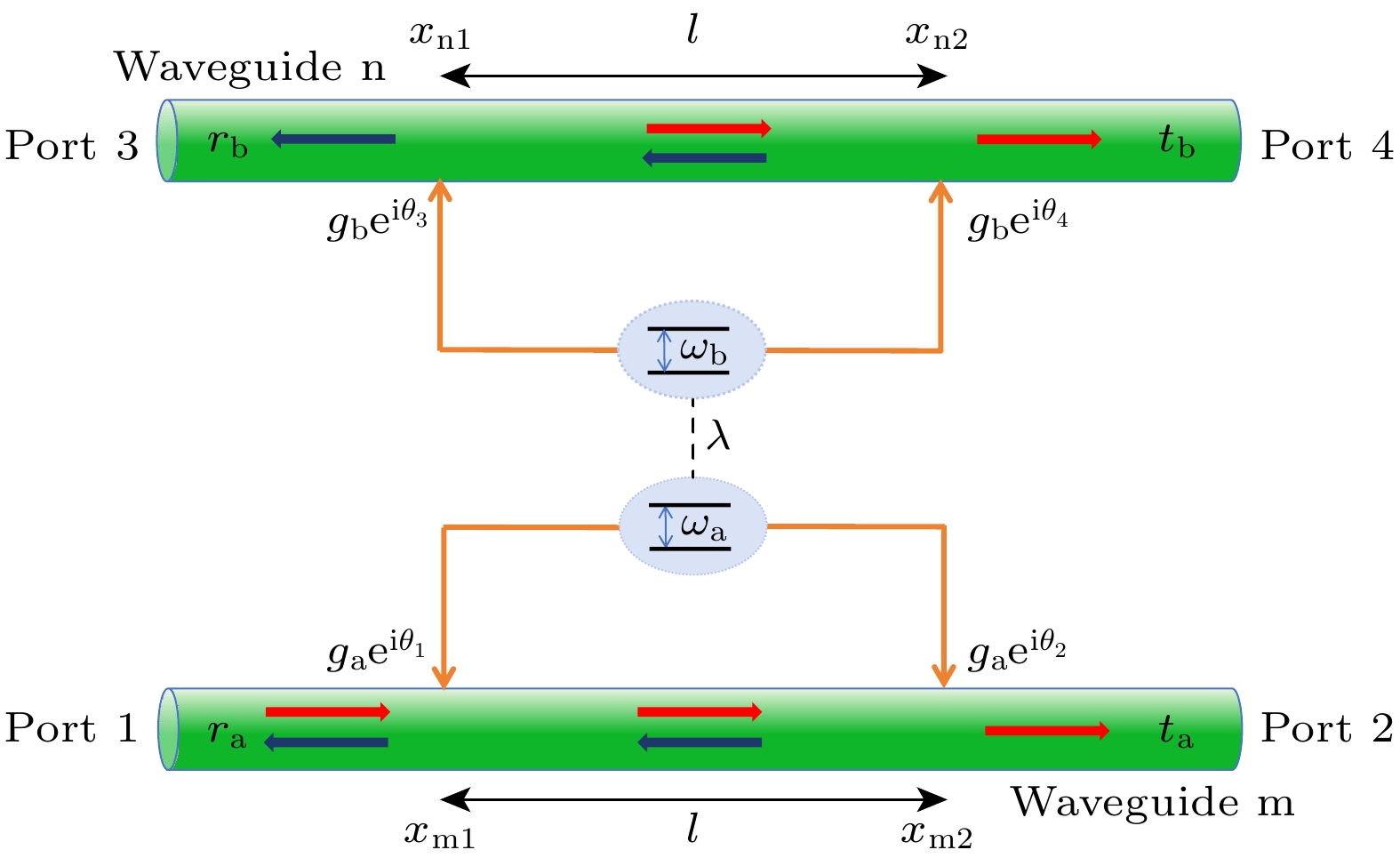
 DownLoad:
DownLoad:
